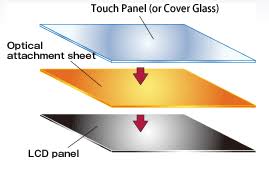Optical Bonding
Blaze Display Technology Co., Ltd. | Updated: Nov 27, 2018
Optical bonding process is the process of laminating cover glass or touch screens to the LCD cell. Silicone gel or other adhesive, or use OCA gel to insert between the cover glass and LCD to completely fill the air gap. The assembly is cured in a process that affixes the panels together while solidifying the gel.
We may need optical bonding for Protection‐LCDs have plastic surfaces that are not vandal or weatherproof.
To protect your display investment most LCD installations, require a cover glass or polycarbonate lens to protect the LCD.
Optical bonding OCA
Optical bonding technique fills the air gap with Optical Clear Adhesive or OCA. While the optical index of OCA is designed to be very close to that of glass, light reflection at those two interfaces is minimized. Since less ambient light is bounced off the interfaces with optical bonding, the dark image remains as dark as it should be and the contrast ratio as well as the color saturation are restored back to the level when touch panel was not there.
Likewise, backlight of LCM experiences less reflection loss when it propagates through the interfaces with OCA, and the brightness off the touch panel is up as if the TP was not there. Optical bonding is implemented by either liquid or sheet form OCA. The high cost of both processes is mainly due to un-recoverable yield loss issue.
Optical bonding services
Optical bonding services plays a decisive role in the display which is installed in the highly humid, outdoor, or harsh environments due to its enhanced ruggedness and visual performance to the display. There are some factors that affect displays’ readability. The most common one is “fog”, or condensation, which forms on the inner surface of display's vandal shield. Another factor is the reflection of sunlight, which causes a mirror-image on the display. Reflection is caused by optical index mismatch between air and the glass. Both issues can be solved by using optical bonding. Not only optical improvement, using optical bounding technology with a protective cover glass can also improve scratch and damage resistance.
With touch panel attached to LCM, the display suffers not only brightness going down but also the deteriorating in display quality. Especially the reflection of ambient light causes the dark image being not as dark as it supposed to be. By adding the process of Optical Bonding, we can reduce the brightness loss and avoid the influence of ambient light.
Reflection appears when light propagates through media with different optical indices. The reflection energy is around 4% of incident light at each air-glass interface. As touch panel attached to LCM with air gap, two additional air-dielectric interfaces contribute to light reflection.


